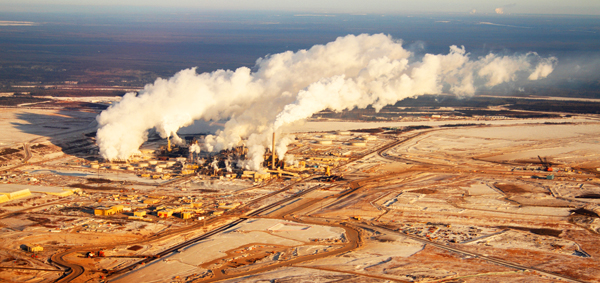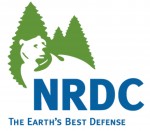
Tarsands facility, Northern Alberta. ©Christopher Kolaczan, Shutterstock. Used with permission.
By Scott Dodd
Editor, OnEarth
Natural Resources Defense Council
Scott Dodd is editor of OnEarth, the excellent print and online magazine of the Natural Resources Defense Council. EarthDesk heartily recommends you follow OnEarth for top-notch analysis of breaking environmental issues. This post appeared in the January 31, 2014 online edition. More about Scott, OnEarth and NRDC at the conclusion.
The U.S. State Department released its final environmental analysis of the proposed Keystone XL tar sands oil pipeline today, and many scientists and advocates who have spent years making the case that it would be an environmental disaster don’t much like the results—even though the department, for the first time, acknowledges that the project could worsen climate change.
Ultimately, however, the report concludes that the overall impact of a $5 billion pipeline shipping tar sands oil to Gulf Coast refineries and overseas markets would be largely neutral. How so? It argues that oil will be extracted from western Canada’s Alberta tar sands fields one way or another, so “approval or denial of any one crude oil transport project … remains unlikely to significantly impact the rate of extraction in the oil sands, or the continued demand for heavy crude oil at refineries in the United States.”

The State Department study acknowledges that the additional carbon pollution from KXL would be like putting up to 5.7 million new cars on the road — or building close to eight new coal-fired power plants.
— Scott Dodd, OnEarth, NRDC
The analysis doesn’t end the debate, and State Department officials were quick to say that they’ve made no final decision. But it does trigger what appears to be the endgame in the more than five-year battle over transporting tar sands oil across the American heartland. Federal agencies now have 90 days to weigh in on President Obama’s final decision, with a 30-day public comment period. NRDC (which publishes OnEarth) and other environmental advocates declared that the report gives the president all the ammunition he needs to turn down the project.
This isn’t the first State Department analysis of the pipeline. A 2011 report had to be scrapped after local opposition to the project in Nebraska forced TransCanada to draw up a new route (and let Obama put his decision off until after the 2012 election). Then a draft re-analysis issued last year was widely criticized as flawed—including by the Environmental Protection Agency. There was also evidence that the State Department’s consultant had a financial conflict of interest, which is under investigation.
Today’s report acknowledges more serious concerns about transporting tar sands oil than the State Department has in the past, though the dangers to wildlife, agriculture, drinking water supplies, and the world’s warming atmosphere weren’t enough to earn the project a clear thumb’s down. If you’re scratching your head over that, it’s probably because you’re at least vaguely aware that pipelines have a poor safety record (witness recent spills that polluted communities and waterways in Michigan and Arkansas), and Keystone XL would cross six major rivers and the Ogallala Aquifer, which provides drinking water and irrigates agriculture in parts of eight states.

Bottom line, the Keystone XL tar sands pipeline is a project that brings risk with no reward.
— Susan Casey-Lefkowitz, NRDC
TransCanada forecast that its first crude oil pipeline, Keystone 1, would leak no more than an average of 1.4 times over a decade. Instead, it had 14 U.S. spills in a single year, and federal regulators had to temporarily shut it down. Since 1986, according to a ProPublica investigation, U.S. pipeline accidents have killed more than 500 people, injured over 4,000, and cost nearly $50 billion in property damages.
Ultimately, though, the pipeline’s fate is likely to come down to its impact on global climate change. President Obama has said so himself, declaring that he wouldn’t issue a permit for the pipeline if it would “significantly exacerbate the problem of carbon pollution.” In a speech last June, he said: “The pipeline’s effect on climate will be absolutely critical to determining whether this project will go forward.”
So that’s the key part of the analysis issued today. And the State Department’s reasoning gives opponents plenty of ground to challenge the report’s “no big deal” conclusion. Though it acknowledges that the additional carbon pollution from KXL would be like putting up to 5.7 million new cars on the road—or building close to eight new coal-fired power plants—the study still assumes that without the pipeline, tar sands oil would be extracted anyway and shipped by alternative means, either by other pipelines or by rail. (The report also rates rail as a riskier safety alternative than pipelines.)
If that sounds like specious reasoning to you, you’re not alone. Other analysts have cast serious doubt on the conclusion that tar sands extraction would continue at the same rate without KXL. A Goldman Sachs report last year, for instance, questioned whether rail shipments could replace a pipeline slated to transport 830,000 barrels of crude per day. And the Royal Bank of Canada has said that blocking Keystone XL would significantly inhibit Canada’s tar sands development.
Even the EPA has been critical of the State Department’s analysis. After the department’s draft conclusions were released last March, the EPA filed a response saying that the report had downplayed the pipeline’s impact on carbon pollution. A coalition of environmental groups, including NRDC, published a report last year arguing that KXL would increase U.S. carbon emissions by far more than the State Department said today—the yearly equivalent of building 51 new coal-fired power plants or putting 37 million additional cars on the road.
TransCanada has been awaiting a U.S. decision on the project for more than five years—though “waiting” is hardly the right word, since in the interim the company has already built the pipeline’s southern leg from Oklahoma to Texas and worked to gain all of the land necessary for the project’s right-of-way, including by using the threat of eminent domain. OnEarth editor-at-large Ted Genoways, who is based in Nebraska, has extensively covered TransCanada’s hardball tactics and the resulting backlash in cornhusker country, including citizen lawsuits that could still impede the project, even if it wins Obama’s OK.
It’s hard to convince people if it looks like the game is rigged, and the government’s process for evaluating the pipeline has been plagued by conflicts of interest. ERM Group, the agency’s primary contractor on today’s environmental study, has financial ties to TransCanada—a fact the department tried to hide, as Mother Jones reported last year—and is a member of of industry groups that have lobbied for the pipeline’s approval.
Buzzfeed revealed Thursday that TransCanada even recommended ERM to the State Department, saying that the consulting firm had no significant conflicts. (And ERM is actually the second firm hired by the State Department on the Keystone project that counts TransCanada as a client.) All of this is under investigation by the State Department’s Inspector General, and a report is expected soon.
So there’s plenty to draw on if the president wants to nix the pipeline. Conservationists will continue to press him—they’ve already staged massive protests and civil disobedience at the White House in recent years and made the pipeline an important political issue. “Bottom line,” wrote NRDC international program director Susan Casey-Lefkowitz, “the Keystone XL tar sands pipeline is a project that brings risk with no reward.”
In his State of the Union address on Tuesday, the president said “we have to act with more urgency” on climate change in order to leave our children and grandchildren “a safer, more stable world, with new sources of energy.” KXL opponents hope to hold him to that.
«« »»
 Scott Dodd is the editor of OnEarth.org and an adjunct professor at the Columbia University Graduate School of Journalism. He was a newspaper reporter for 12 years, contributing to coverage of Hurricane Katrina that won a Pulitzer Prize, and has written for Scientific American, Slate, and other publications.
Scott Dodd is the editor of OnEarth.org and an adjunct professor at the Columbia University Graduate School of Journalism. He was a newspaper reporter for 12 years, contributing to coverage of Hurricane Katrina that won a Pulitzer Prize, and has written for Scientific American, Slate, and other publications.
OnEarth (pronounced “on earth,” not “one earth”) is a quarterly magazine and daily online publication of thought and opinion about the environment. It explores the contemporary environmental landscape through the lenses of science, public health, technology, culture, business, food, and politics. Our original, in-depth reporting examines the challenges that confront our earth and its inhabitants, and our expert analysis evaluates the most promising solutions.
 From the NRDC website: “NRDC is the nation’s most effective environmental action group, combining the grassroots power of 1.4 million members and online activists with the courtroom clout and expertise of more than 350 lawyers, scientists and other professionals.
From the NRDC website: “NRDC is the nation’s most effective environmental action group, combining the grassroots power of 1.4 million members and online activists with the courtroom clout and expertise of more than 350 lawyers, scientists and other professionals.
The New York Times calls us ‘One of the nation’s most powerful environmental groups.’ The National Journal says we’re ‘A credible and forceful advocate for stringent environmental protection.'”









